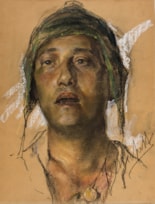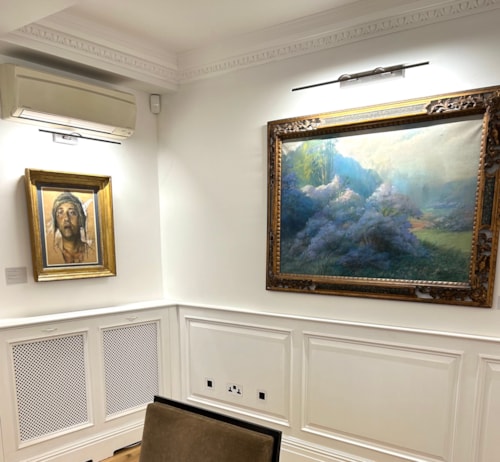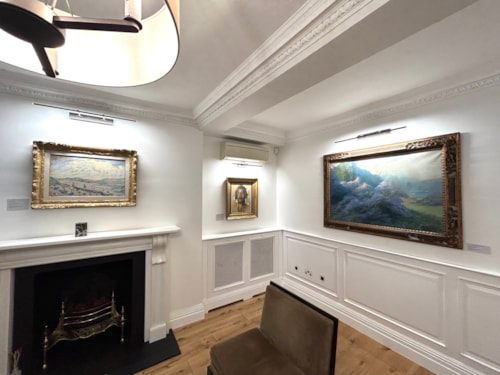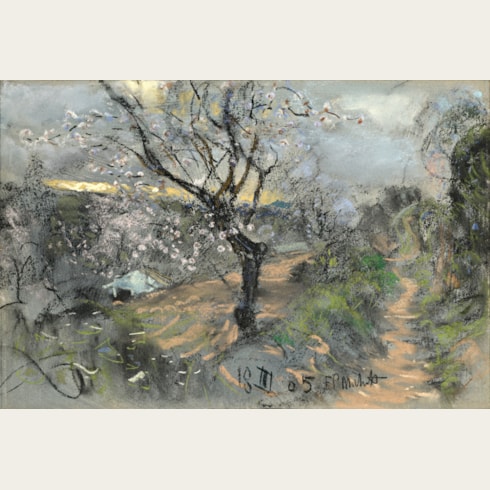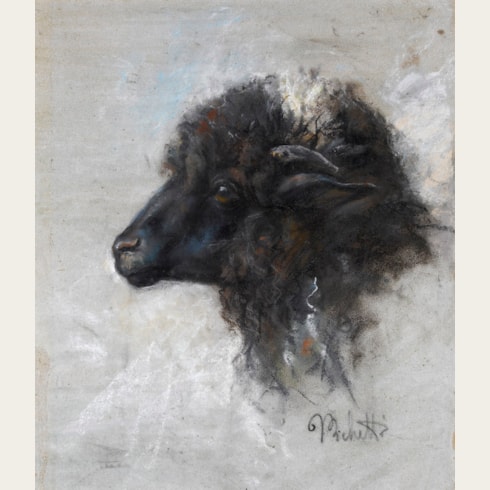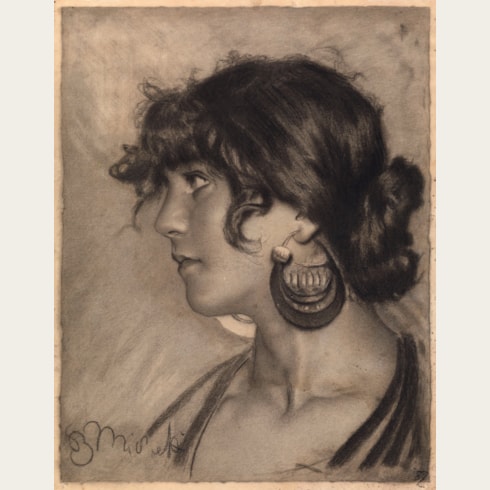Francesco Paolo MICHETTI
(Tocco di Casauria 1851 - Francavilla al Mare 1929)
The Head of a Youth
Charcoal, black chalk and pastel, on light brown paper.
Signed FP Michetti at the lower right.
463 x 354 mm. (18 1/4 x 13 7/8 in.)
Signed FP Michetti at the lower right.
463 x 354 mm. (18 1/4 x 13 7/8 in.)
As one Italian writer has aptly noted, ‘The Abruzzi landscape truly spoke to Michetti’s heart with its many voices; he heard them all and absorbed them all. The sea and the mountains, the local festivals so full of colour, of movement, of joy, the mystic processions, the pageantry of superstition and faith in the naves of the solemn age-old cathedrals and of the silent basilicas, the peaceful labour in the fields, the olive-clad hills, the people with their keen sensitiveness and their primitive tenacious passions, deeply impressed his feelings; in black-and-white or in colour, in innumerable marvellous drawings and in paintings of unforgettable beauty and imperishable interest he expressed the fascination, the poetry, the sweetness and the ruggedness, the character and the variety of those scenes. He was indeed a sublime interpreter of the Abruzzi and of their people, whose faces and souls he portrayed in fundamental and everlasting lines.’
This striking pastel study may be related to one of the seated onlookers in Francesco Paolo Michetti’s very large painting of The Daughter of Jorio of 1895, in the Palazzo della Provincia in Pescara, of which a somewhat smaller variant is in a private collection. The subject of Michetti’s painting was inspired by a scene he and his friend Gabriele d’Annunzio witnessed in the artist’s home town of Tocco di Casauria one summer day, when a young woman, dressed in red, was chased through the town square by a number of drunken farm labourers.
Several years after Michetti painted his work, the subject was adapted by d’Annunzio into the play La figlia di Iorio, written in 1903 and first performed the following year. The play, which takes place in the Abruzzi and contains dialogue in the Abruzzese dialect as well as local proverbs and rhymes, tells the story of a love between an outcast girl, accused of being a witch, and the shepherd Aligi, who is betrothed to a woman he does not love.
The present sheet would appear to be an unused or initial study for the head of the second man from the left4 in the finished painting of The Daughter of Jorio, for whom the model may have been the painter and musician Paolo De Cecco, another member of Michetti’s circle at the Conventino. A related grisaille study of what appears to be the same model as in the present sheet, more definitively related to the seated figure in the painting of The Daughter of Jorio, is in a private collection. A pen and ink study for the grisaille is in the Accademia di Belle Arti in Naples.
A similar youth in an identical cap also appears in Michetti’s design for the cover of the book Abruzzo forte e gentile: Impressioni d’occhio e di cuore by Primo Levi, published in 1883.
This striking pastel study may be related to one of the seated onlookers in Francesco Paolo Michetti’s very large painting of The Daughter of Jorio of 1895, in the Palazzo della Provincia in Pescara, of which a somewhat smaller variant is in a private collection. The subject of Michetti’s painting was inspired by a scene he and his friend Gabriele d’Annunzio witnessed in the artist’s home town of Tocco di Casauria one summer day, when a young woman, dressed in red, was chased through the town square by a number of drunken farm labourers.
Several years after Michetti painted his work, the subject was adapted by d’Annunzio into the play La figlia di Iorio, written in 1903 and first performed the following year. The play, which takes place in the Abruzzi and contains dialogue in the Abruzzese dialect as well as local proverbs and rhymes, tells the story of a love between an outcast girl, accused of being a witch, and the shepherd Aligi, who is betrothed to a woman he does not love.
The present sheet would appear to be an unused or initial study for the head of the second man from the left4 in the finished painting of The Daughter of Jorio, for whom the model may have been the painter and musician Paolo De Cecco, another member of Michetti’s circle at the Conventino. A related grisaille study of what appears to be the same model as in the present sheet, more definitively related to the seated figure in the painting of The Daughter of Jorio, is in a private collection. A pen and ink study for the grisaille is in the Accademia di Belle Arti in Naples.
A similar youth in an identical cap also appears in Michetti’s design for the cover of the book Abruzzo forte e gentile: Impressioni d’occhio e di cuore by Primo Levi, published in 1883.
A pupil of Domenico Morelli at the Accademia di Belle Arti in Naples, Francesco Paolo Michetti enjoyed his earliest success in Paris, where he participated in the Salons of 1872 and 1875. However, it was not until 1877, when his large canvas of The Procession of the Corpus Domini at Chieti was exhibited in Naples to popular acclaim, that he secured his reputation in Italy. Michetti developed a distinctive style of painting, with the use of bold colours and vibrant effects achieved with a virtuoso technique. A common thread in his work is his interest in rural themes, and particularly the beliefs and traditions of his native Abruzzi region, seen in such paintings of the 1880’s as The Vow, now in the Galleria Nazionale d’Arte Moderna in Rome. A close friend of Gabriele d’Annunzio, who published an essay on the artist in 1896, Michetti exhibited frequently throughout Italy, often showing large groups of studies in pastel and tempera.
At the third Biennale in Venice, held in 1899, Michetti was honoured with a retrospective exhibition of some two hundred works covering the whole of his career. His last major paintings, large canvases entitled The Cripples and The Snakes which continued his interest in local customs, were exhibited at the Exposition Universelle in Paris in 1900. After 1900 Michetti seems to have abandoned painting in favour of photography, becoming one of the first artistic practitioners of the new medium in Italy. In fact, by the early 1880’s Michetti had already begun to base his paintings and drawings on his own photographs, preferring these to using posed models in his studio. During the last thirty years of his life, Michetti continued to experiment with photography, while also producing a series of almost monochromatic drawings and sketches in gouache, oil and pastel, until his death in 1929.
As a draughtsman, Michetti had a particular fondness for the pastel medium, which he was able to exploit for its strong colour and luminous effects. He was introduced to the medium by the painter Eduardo Dalbono, and from about 1877 onwards worked as a draughtsman almost exclusively in pastel or mixed media. His use of the pastel medium was also to be a distinct influence on a number of younger artists in Naples, such as Giuseppe Casciaro.
Provenance
Galleria Fogliato, Turin
Anonymous sale, Milan, Sotheby’s, 18 June 2008, lot 6.
Anonymous sale, Milan, Sotheby’s, 18 June 2008, lot 6.


